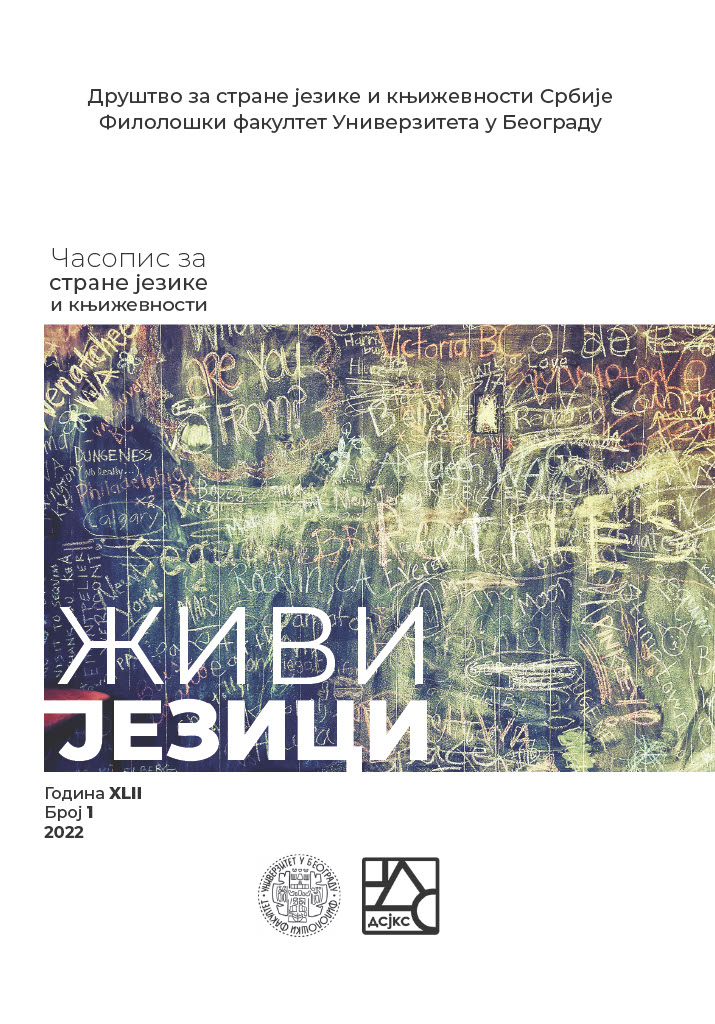Prepositional complements in Serbian and German: Analysis of realisations in a Thomas Mann’s short story
DOI:
https://doi.org/10.18485/zivjez.2022.42.1.5Keywords:
prepositional complement, dependency grammar, preposition, German, English, Tomas Mann, Schwere StundeAbstract
After a brief presentation of the fundamentals of dependency grammar, on which this paper is based, and after introducing the characteristics of prepositions as a word class, of prepositional phrases and prepositional complements in German and Serbian language, this paper primarily aims to demonstrate an analysis of the realisations of prepositional complements in the original and the translation of Thomas Mann’s short story Schwere Stunde (Weary Hour), in order to identify similarities and differences that exist in this area, but also to determine other tendencies that are typical for this class of complements. As the analysis of the selected corpus showed, the prepositional complement is present in both Serbian and German to a large extent and is characterized by numerous realisation possibilities. One of the most important conclusions reached in the process of comparing these possibilities in both languages include a relatively large similarity in terms of potential realisations. It should also be mentioned that there are numerous variances that partly depend on interlinguistic differences and partly come from artistic or translational freedom.
References
Primary
Mann 1980: Приповетке I-II, прев. Б. Петровић, Нови Сад: Матица српска. / Pripovetke I-II, prev. B. Petrović. Novi Sad: Matica Srpska.
Mann 2008: T. Mann, Der Tod in Venedig und andere Erzählungen. Frankfurt am Main: Fischer Taschenbuch Verlag.
Secondary
Altmann, H. & S. Hahnemann 2010. Prüfungswissen Syntax. Arbeitstechniken – Klausurfragen – Lösungen. Göttingen: Vandenhoeck & Ruprecht GmbH & Co. KG.
C. Dürscheid, C. 2021. Syntax. Grundlagen und Theorien. Göttingen: Vandenhoeck & Ruprecht GmbH & Co. KG.
Đorđević, M. & U. Engel. 2009. Wörterbuch zur Verbvalenz Deutsch-Bosnisch/Kroatisch/Serbisch. München: Iudicium Verlag.
Engel, U. 1996. Deutsche Grammatik. 3., korrigierte Auflage. Heidelberg: Groos.
Engel, U., Mrazović, P., & Đukanović, J. 1986. Kontrastive Grammatik Deutsch-Serbokroatisch. [Halbbd. 1]. München: Otto Sagner.
Engel, U., Srdić, S., & Alanović, M. 2012. Deutsch-serbische kontrastive Grammatik. Teil I: Der Satz. München: Sagner.
Mrazović, P., & Vukadinović, Z. 1990. Gramatika srpskohrvatskog jezika za strance [Grammatik der serbokroatischen Sprache für Ausländer]. Novi Sad: Izdavačka knjižarnica Zorana Stojanovića.
Mrazović, P., & Vukadinović, Z. 2009. Gramatika srpskog jezika za strance. Novi Sad: Izdavačka knjižarnica Zorana Stojanovića.
Pafel, J. 2011. Einführung in die Syntax. Grundlagen – Strukturen – Theorien. Stuttgart u.a.: Metzler Verlag.
Pittner, K., & J. Berman. 2013. Deutsche Syntax. Ein Arbeitsbuch. Tübingen: Narr.
Helbig, G. 1971. Beiträge zur Valenztheorie. Halle (Saale): VEB Max Niemeyer Verlag.
Published
How to Cite
Issue
Section
License
Copyright (c) 2022 Невена Ковачевић

This work is licensed under a Creative Commons Attribution-NonCommercial-ShareAlike 4.0 International License.


